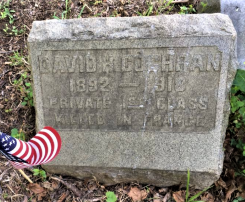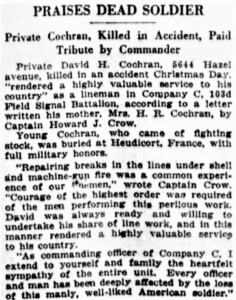Title: Army Private First Class, World War I
Birthdate: February 9, 1892
Death Date: December 25, 1918
Plot Location: Section 140, Lot 38, north line

David grew up in the Mill Creek neighborhood of West Philadelphia, the son of a salesman and his wife, with an older brother and sister. By age 18 he was an apprentice with a tin roofing company and later became a machinist.
In early 1916 a Mexican revolutionary general named Francisco “Pancho” Villa crossed the border and raided several U.S. towns. It was in response to the United States recognizing a rival faction during the Mexican Civil War of 1910-1920. President Woodrow Wilson responded by asking each state to mobilize the National Guard. David responded by enlisting on June 21 in Company C of the 1st Infantry.
The regiment was sent to Camp Stewart in El Paso, Texas for training, which lasted about two months. By that time the threat of any further invasion was gone, so David’s unit came home and was deactivated in October.The training was valuable because the guardsmen were called up again on March 28, 1917, a few weeks before America entered the war in Europe.
The 1st Infantry was renamed the 109th at that time, part of the 28th Division. By the end of 1917 David was transferred to the 103rd Field Signal Battalion. An intricate system of telephone lines was strung, buried, and frequently cut, but it was an improvement over rudimentary communications like rockets, flares, signal lamps, homing pigeons, and human messengers (“runners”).
The 103rd supported the 28th Division in the Second Battle of the Marne, the campaign against Fismes, the united Allied attacks on the Vesle River, and the Meuse-Argonne Offensive. General John Pershing, commander of the American Expeditionary Force, nicknamed the 28th “the Iron Division” for the bravery they showed.
David survived the end of the war, but on Christmas Day, 1918, he was accidentally killed when a dug-out caved in on him. He was buried in a French cemetery, so his gravestone here is a cenotaph, a marker remembering one who is buried elsewhere.


Support the Friends of Mount Moriah
Help us in our mission to restore and maintain the beautiful Mount Moriah Cemetery by donating to our cause or volunteering at one of our clean-up events.

